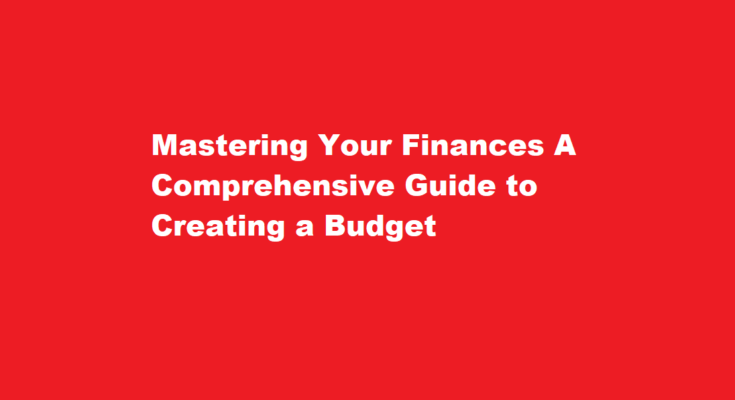Introduction
In today’s fast-paced world, managing personal finances is crucial to achieving financial stability and securing a brighter future. One of the fundamental tools for effective financial management is creating a budget. A budget is a detailed plan that outlines your income and expenses, enabling you to make informed financial decisions and track your spending. In this article, we will provide you with a step-by-step guide on how to create a budget that aligns with your financial goals, empowers you to control your finances, and sets you on the path to financial success.
Assess Your Financial Situation
To build a solid budget, you must first understand your current financial position. Start by calculating your total income from all sources, including your salary, freelance work, rental income, or any other revenue streams. Next, gather information about your regular monthly expenses, such as rent/mortgage, utilities, groceries, transportation, and debt payments. This step will help you get a clear picture of your financial inflow and outflow.
Define Your Financial Goals
Determine your short-term and long-term financial objectives. Are you saving for a dream vacation, planning for a down payment on a house, or saving for retirement? Understanding your goals will help prioritize your spending and keep you motivated throughout your budgeting journey.
Categorize Your Expenses
Organize your expenses into fixed and variable categories. Fixed expenses, such as rent and insurance, remain constant each month, while variable expenses, like entertainment or dining out, fluctuate. This classification will aid in identifying areas where you can cut back to increase savings.
Create a Realistic Budget
Crafting a budget that aligns with your lifestyle and financial objectives is essential. Allocate a portion of your income to each expense category, ensuring that you leave room for savings and emergency funds. Be realistic in your estimations and avoid overestimating your savings potential.
Track Your Spending
Consistently monitoring your spending is a critical aspect of budgeting. Use budgeting apps, spreadsheets, or old-fashioned pen and paper to record your expenses daily. Tracking your spending will reveal where you tend to overspend and help you make necessary adjustments.
Reduce Unnecessary Expenses
After analyzing your spending patterns, identify areas where you can cut costs. Look for subscriptions or services you no longer use and cancel them. Consider packing lunch for work instead of eating out or finding cost-effective alternatives for entertainment.
Save and Invest Wisely
Once you’ve successfully managed to reduce unnecessary expenses, allocate a portion of your income to savings and investments. Establish an emergency fund with enough to cover at least three to six months’ worth of living expenses. Additionally, consider various investment options to grow your money, such as stocks, bonds, or retirement accounts.
Manage Debt Strategically
If you have debts, prioritize paying them off systematically. Start by focusing on high-interest debts first, as they can quickly accumulate and become financially burdensome. Make consistent payments above the minimum to reduce the overall interest paid.
Review and Adjust Regularly
Life is dynamic, and your financial situation may change over time. Regularly review your budget and make adjustments as necessary. For instance, if your income increases, consider allocating more to savings or investments. Flexibility is key to maintaining a successful budget.
Seek Professional Guidance
Creating and managing a budget can be overwhelming, especially if you have complex financial situations or goals. If needed, don’t hesitate to seek advice from a financial advisor. They can offer tailored solutions and provide expert insights to optimize your budgeting strategies.
FREQUENTLY ASKED QUESTIONS
What is the 50 30 20 budget rule?
Those will become part of your budget. The 50-30-20 rule recommends putting 50% of your money toward needs, 30% toward wants, and 20% toward savings. The savings category also includes money you will need to realize your future goals.
How should I divide my salary?
The 50/30/20 rule of budgeting is a simple method that helps you manage your money more effectively. This basic thumb rule is to divide your post-tax income into three spending categories – 50% for needs, 30% for wants, and 20% for savings.
Conclusion
Building a budget is an empowering and transformative process that empowers you to take control of your finances. By understanding your financial situation, setting clear goals, categorizing expenses, and consistently tracking your spending, you can create a realistic budget that aligns with your aspirations. Remember, budgeting is not about restriction but about making mindful choices that lead to a more secure financial future. Stay disciplined, be patient, and continuously adapt your budget to suit your evolving needs. With time and commitment, you’ll experience the freedom and peace of mind that come with financial well-being.
Read Also : Mastering The Art of Sewing a Button A Step-by-Step Guide



